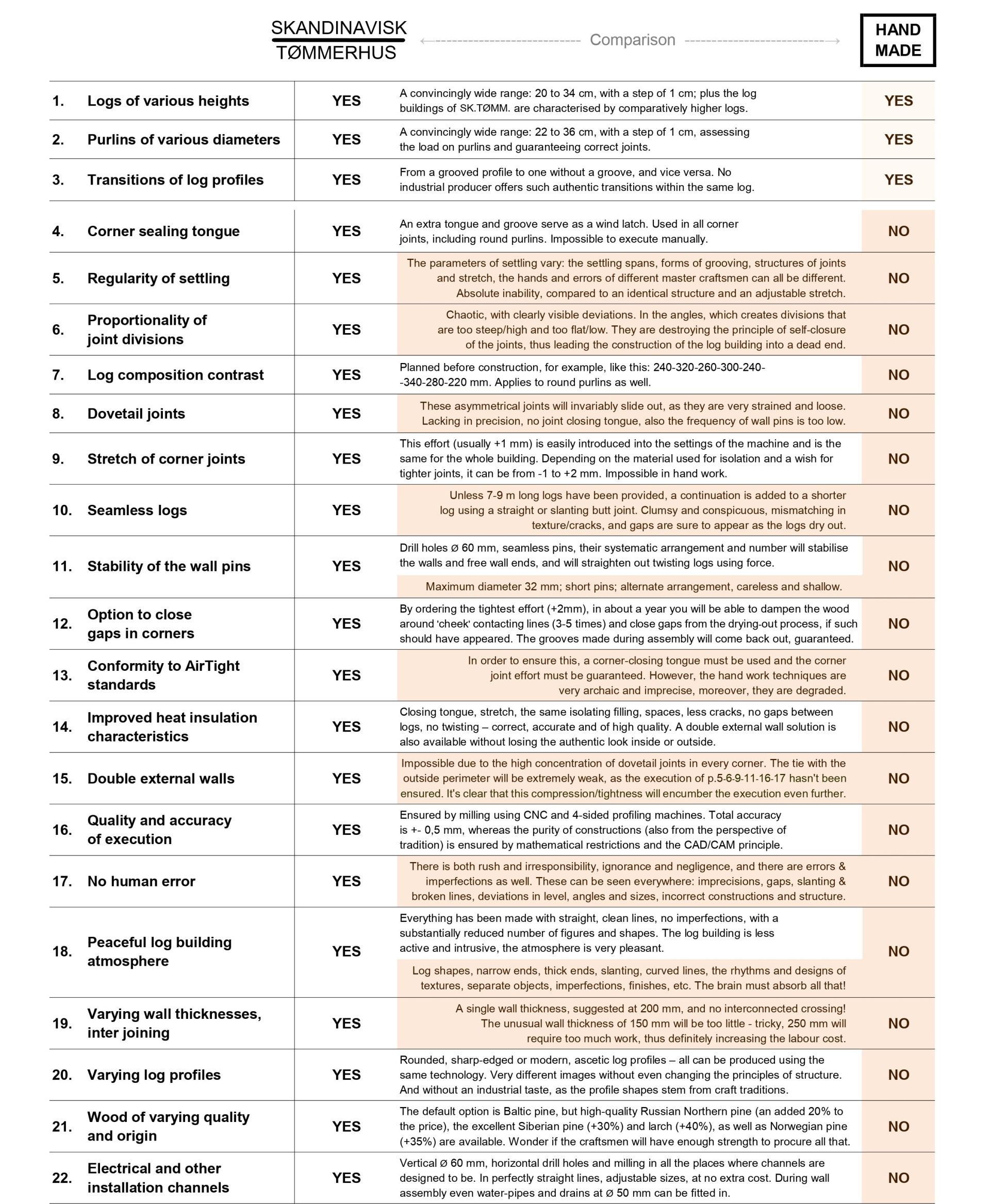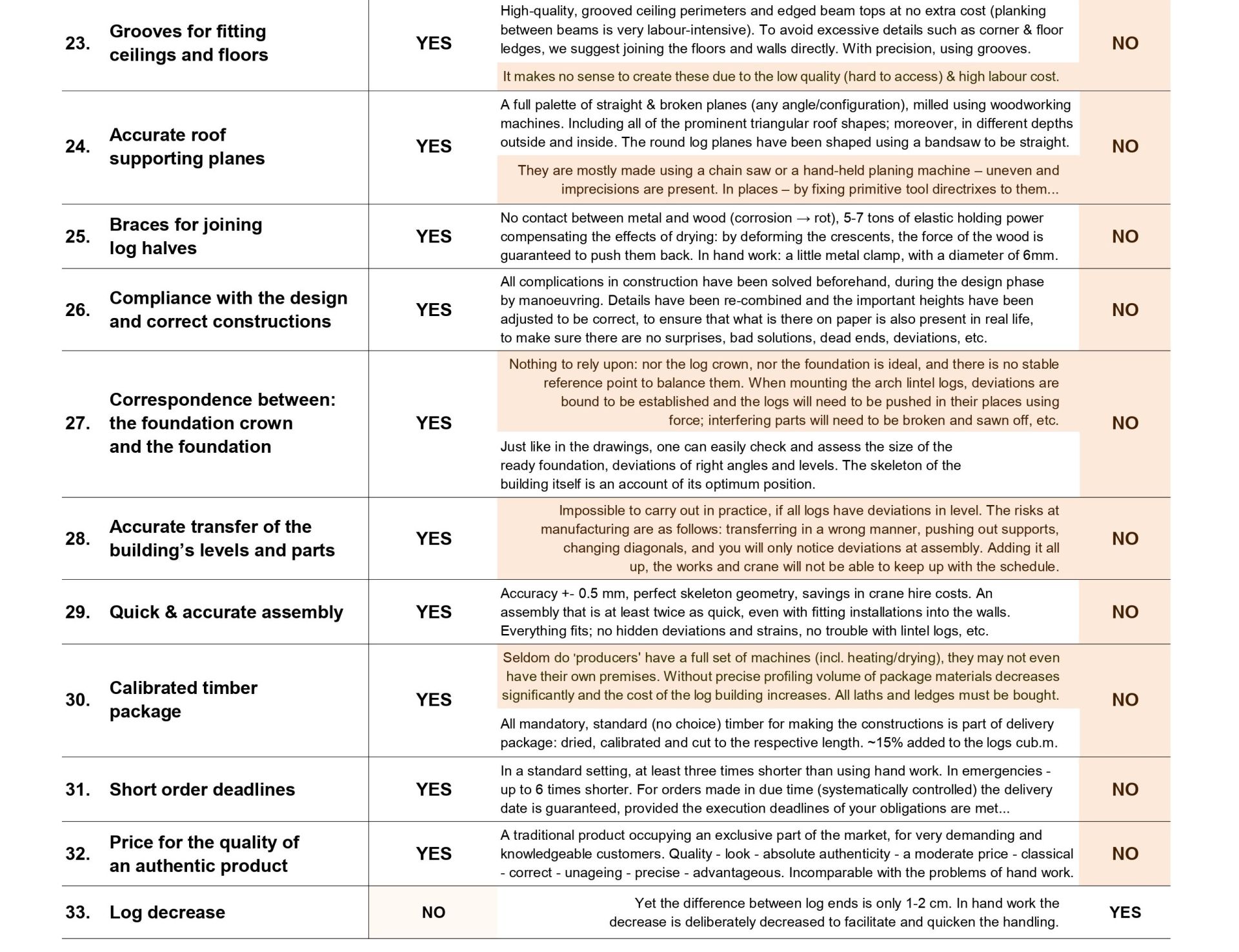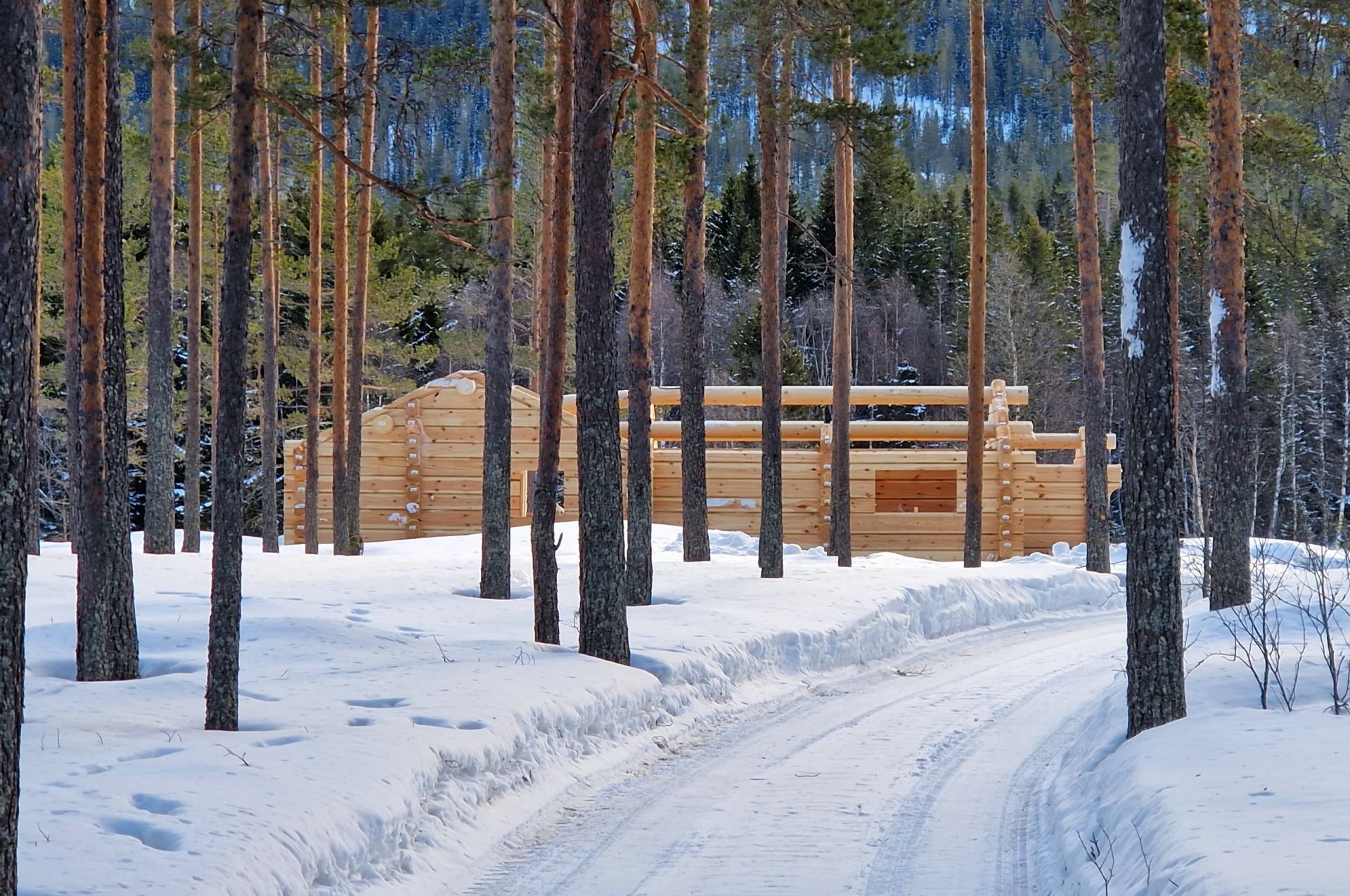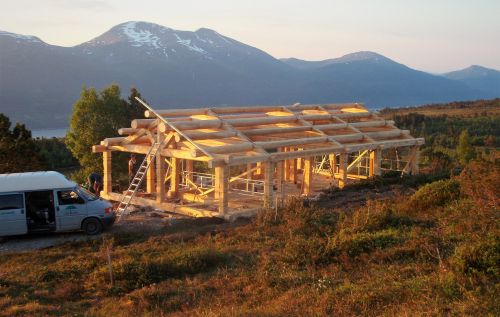So, the main concern is all about log houses. Someone still exists in this world who cannot stop thinking about the decline, regress and degradation of log houses in this era of an overall technological boom and progress of knowledge. Yes, because this does not seem logical, at least to us it doesn’t. Therefore, we promise to expand this topic, which is not as simple as it may seem but which is near and dear to the hearts of many, and its versatile assessment on an especially grand scale. We are certain that this, the so called internet blog, will be able to quite easily create many continuations to this topic which will not be affected and cut short by the censorship of the press. There is surely not a lack of topics and issues.
Unfortunately, we were denied a publication of such series of articles in specialized building magazines, not even for a fee. The rude refusal and excuses of Norwegian press representatives were rooted in entirely ethical considerations. I guess it’s more convenient for them to keep things easy and simply remain ethically quiet. I guess it’s easier for them to crudely and helplessly mutter under their breath and continue to observe how all the valuable things gradually and slowly disappear. Yes, but can one throw up hands in dismay, or put the pen aside even when it comes to the industry upholding the virtuosos of writing, to the feedery itself?
We believe that without great thought or without delving deep into the questions, it is probably not possible to comprehend the different nuances of the problems of the log house industry. To be fair, no one really wants to delve into such topics, because then the destruction of many similar industries becomes very difficult to prevent. Plus, quite a dangerous modern tendency should be considered — marketing has relatively successfully declared itself as almost the only source of information and facts, as well as its mass tools, cheap and euphoric fallacies. Moreover, it does not feel affected by anything, respectively, it makes itself specifically known.
We would like to begin the presentation of our view on log houses and the long-existing issues of the industry by quoting some peaceful insights expressed during the international log house conference proceedings by the President of the Latvian Chamber of Crafts, professor Vilnis Kazaks, who is a true log house enthusiast. They read as follows:
A wooden house has always been and will remain a special type of house separating people from the surrounding environment with a truly natural product. Let us not forget that wooden houses surround us with a unique atmosphere, smells, lines, colors, shapes, sensations of touch… and all of these influences are provided by Nature. They are deeply rooted in our conscious and subconscious mind. In fact, real wooden houses are extremely simple, and that is where their attractiveness lies — there is no extra clutter. And we are not exaggerating by saying that wooden houses are always in demand. Wooden houses, just like any other type of housing, is constantly evolving and in contact with other things.
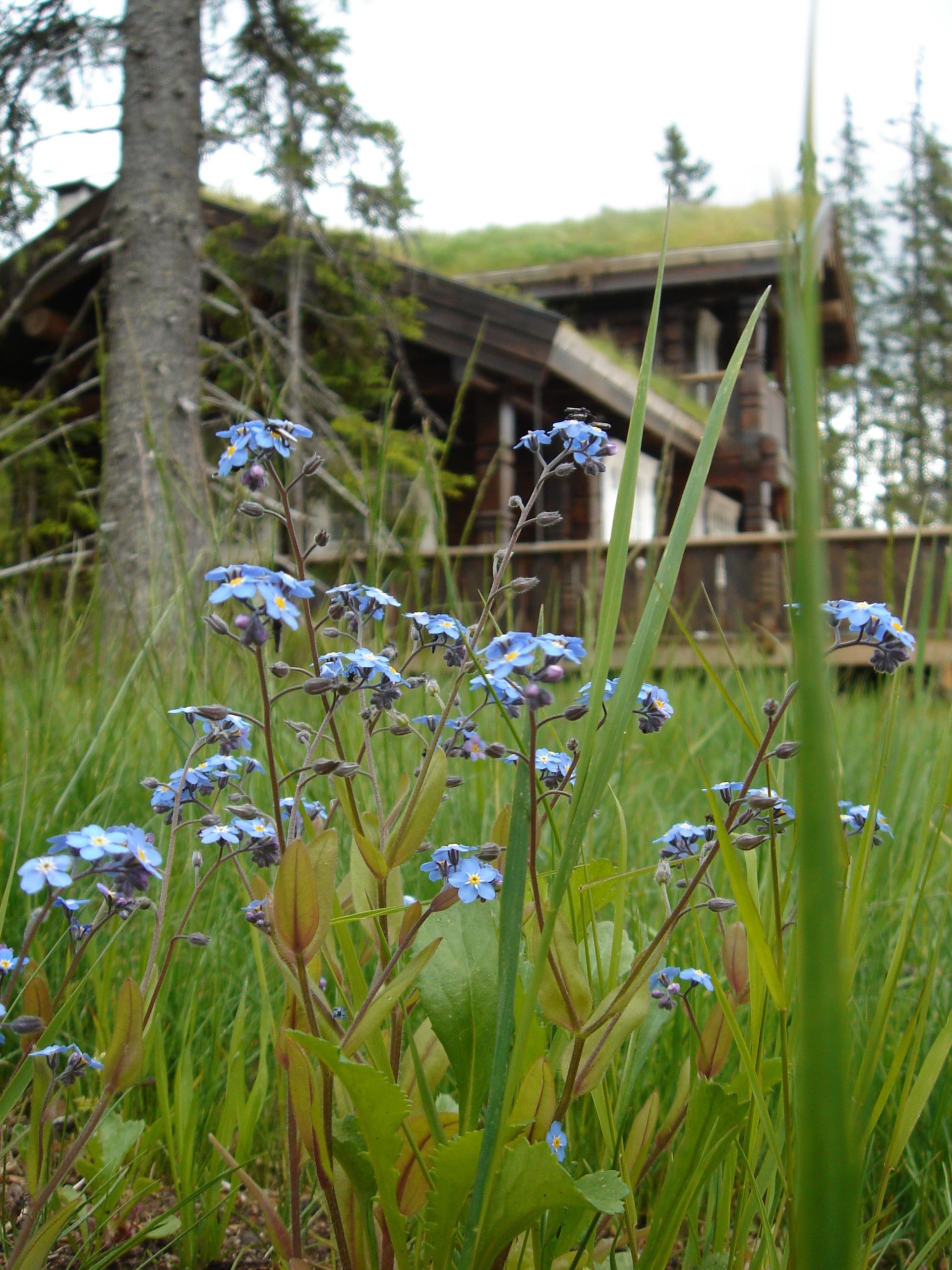
We know that all trees in the forest are wonderful, that they have their lifespans and qualities, but home builders confirm that there are grains growing right and ones growing left, different growth and light conditions and cutting times, transportation and storage techniques, treatment and fitting methods, of course, joints and constructions. Thousands of years have passed to get us from the stone axe to the laser saw, however, any treatment technique leaves its own footprint. Once, by inspecting the mark an axe had left on a wooden surface, people were able to recognize the nature of the craft master — whether this man had been weak or strong, quick or slow… Hand tools changed into mechanized, electrified, pneumatic, electronic tools and work machinery. Many modern wooden houses are built by using completely industrialized methods, but despite the absence of a hand-work craft master, many of the good qualities of the wood have not been lost.
Of course, the main task is to understand the current development of wooden houses, the current situation, as well as the opportunities offered by the near and distant future in a deeper, broader and more accurate way. It is a huge field for housing philosophers, household psychologists, architects, builders, designers, interior designers, decorators, artists and publicists to work in. But the most important task for everyone always is to inform the public about all the benefits of the modern wooden house. The wooden house of the future stands at the crossroads; perhaps some of those roads are still in the making, and in order to improve humanity’s most popular object which not a single person can do without, it expects many industries, companies and personalities to make their contributions.
These quotes have been borrowed from specialists from other industries and from the materials of the last prominent international scientific conference “Construction of Log Houses and Wooden Structures” held in Riga, Latvia, in 2005. Below, a group photo of (part of) participants.

Is it really from the last such conference? As far as Northern Europe is concerned, the answer, unfortunately, is “yes!” because of the rapid recession and decline of the wood craftsmanship industry. Further attempts have been made to organize such conferences in 2007 and 2009, but these, unfortunately, failed, and only separate seminars on the topic have been held. And that’s about it.
By the way, quite a large number of participants took part in the large conference in Riga, to be exact, 157 enthusiasts from 14 countries — craftsmen, researchers, artists, architects, planners, designers, economists and even politicians. And the final resolution of the conference emphasized, among other things, the following:
“Wood offers a natural and changing environment to the human perception — the eyes, ears, nose and the sense of temperature. We know that all that keeps changing is evolving. That, who does not produce anything new, dies, meaning that the wooden environment naturally evolves the physical, physiological and psychological reactions of humans. Home is the stable element of life and environment. The subconscious mind recognizes home. Over the generations, the image of home has grown its roots in our genes, language, fantasy, and our souls. To lose the image of home means to lose one’s soul.”
There was an absolute consensus among the participants, and the following, rather sad fact was stated in the final resolution:
“The work of carpenters is the oldest of them all and most accurately serves the revelation and realization of the client’s idea. But the craft of carpenters can only be learned through passing the knowledge onto the next generation, through apprenticeships by working through the stage of a journeyman carpenter up to becoming a craft master. This offers customers personal contact, and the emotional experiences of human relationships must remain in our memories throughout our lives. Unfortunately, however, it is no longer taken seriously by anyone, and therefore due to economic and technological reasons, this essential, humane, economic and cultural value is rapidly fading away.”
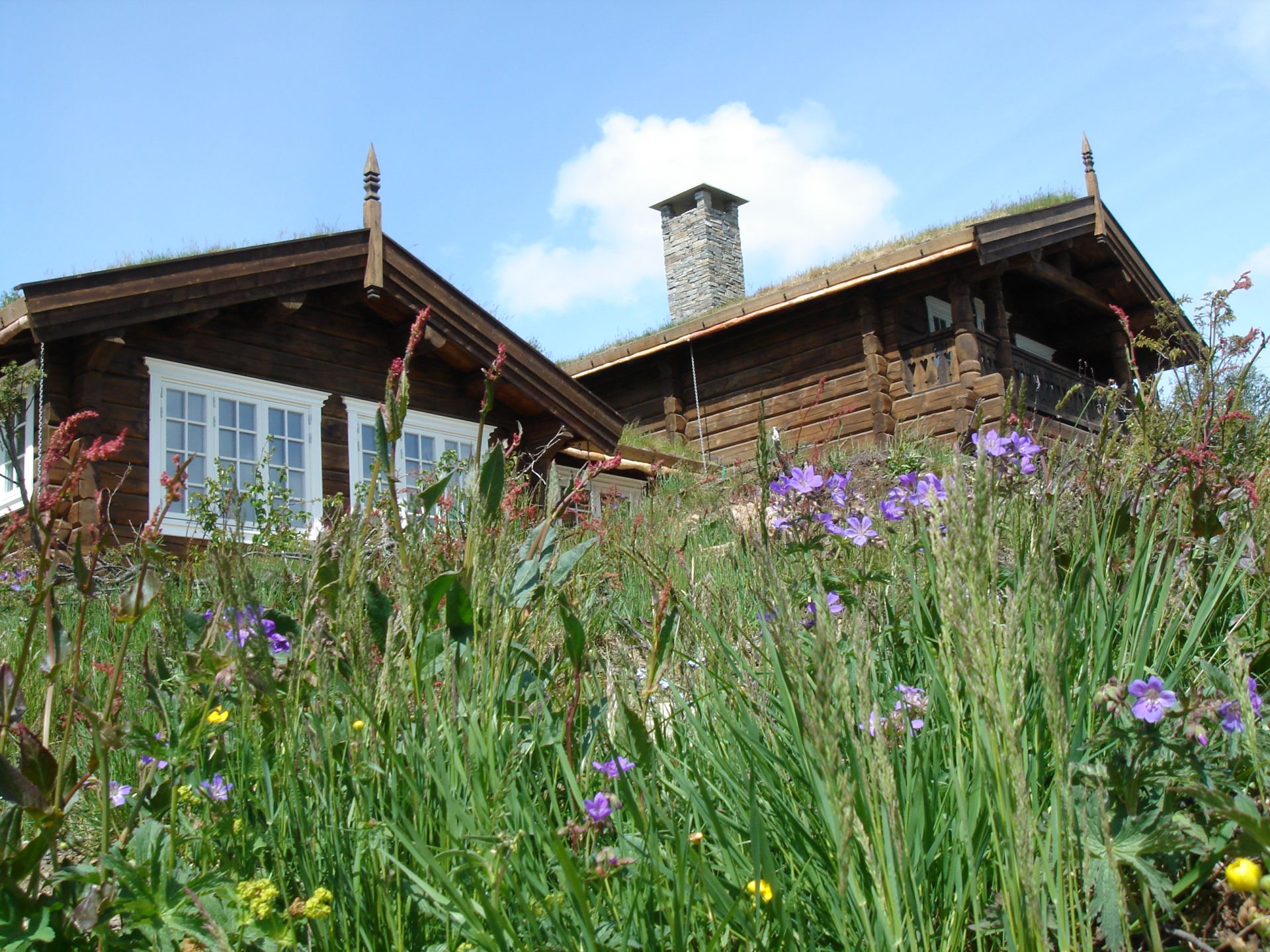
This might sound unnatural, but log houses could be compared to traffic tunnels. Most people know little about the details of the construction of these tunnels, but when passing through them on a normal day they trust that they are safe and of high quality. But it is enough for one of many engineers involved, in fact, in the very complex design of the tunnel to make a single mistake and from the building, which seems very simple from the first glance, turns into a potentially life-threatening trap. At first glance, log houses, too, all seem to be rather simple — just like from the cover of a glossy catalogue. Even more so, spellbound by your fantasy you desire to believe that your chosen log house will be perfect and that you could not make a mistake in choosing the right manufacturer…
However, in reality, a real, traditional, properly constructed log house is not as simple as it may seem. It can surely compete with traffic tunnels in regard to its technological solutions. Unfortunately, one realizes that if technologies, skills and knowledge in the road construction field have been constantly evolving, a considerable fallback has been present in the case of log houses in the recent decades, at least in northern Europe. More and more careless, gross and systematic mistakes are made in the manufacturing and construction stages of log houses, and this easily turns your dreams into a disaster. Perhaps these mistakes do not cause life-threatening consequences, but they surely put pressure on your nerves and your wallet, and quite massively at that.
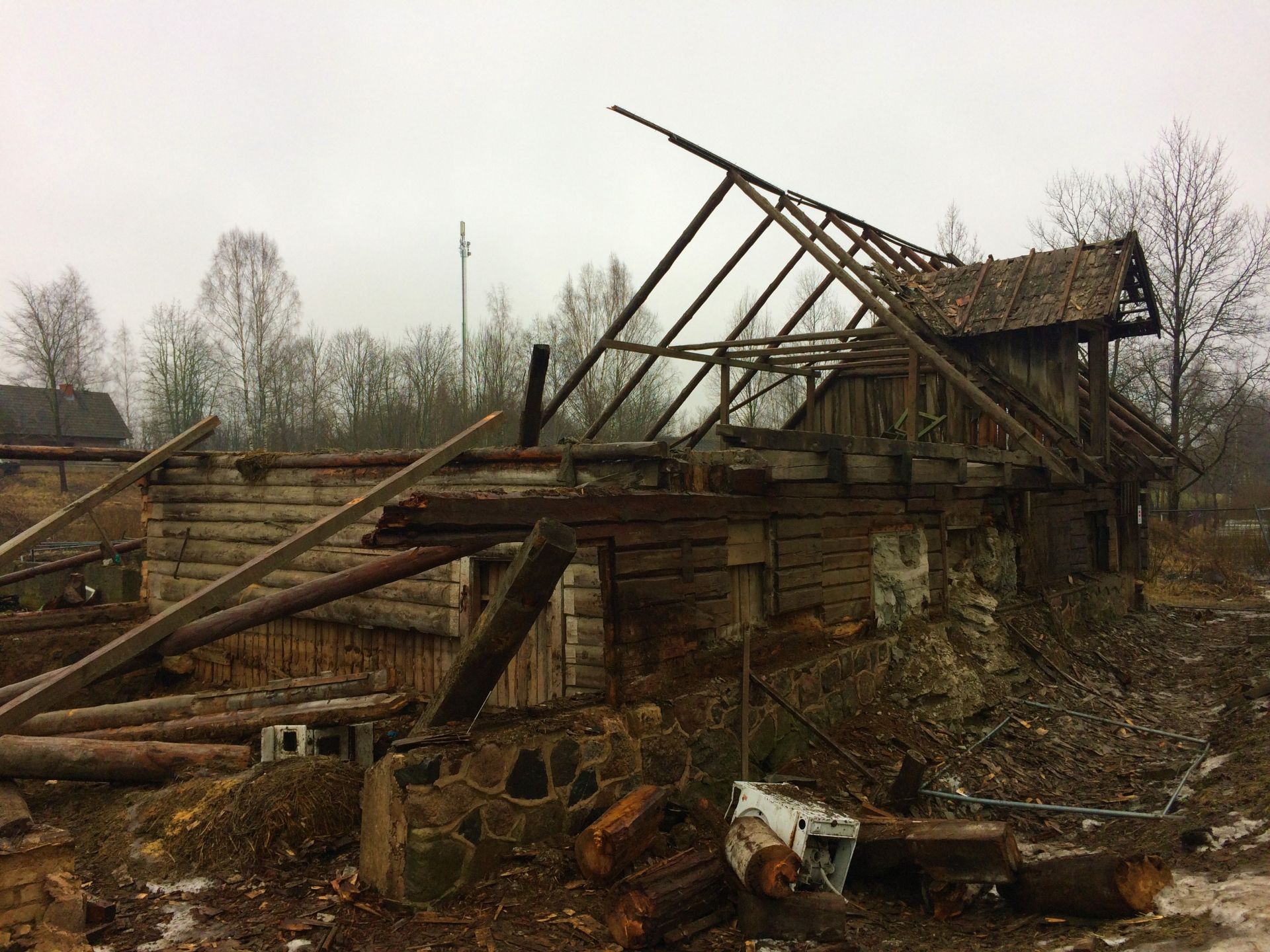
By being aware of the seriousness of this problem and seeing our own solutions to these problems, we understand that it is time for us to finally, with the help of a longer and broader series of publications, to address this issue, which is topical, at least, for Norwegians, and which is not discussed enough on a public scale — the topic of the quality of log houses. Alright, and who is willing to handle this topic so thoroughly? Let us introduce ourselves a little bit:
We are a company named EKO NAMS LLC. EKO means ecological, but NAMS in Latvian is a synonym for the words house and building. In Norway, we are represented by our own subsidiary undertaking — SKANDINAVISK HUS OG HJEM AS. We come from Latvia, a member state of the European Union, and our form of business is SIA (limited liability company). Yes, our country comes up with rather strange entrepreneurship formulations and principles, because by going over the core values of our company, we can safely assure you that we do not take limited responsibility for anything, but rather full responsibility for all things in life. We are located in the town of Līvāni, which is about 175 km east of Riga. The production area covers 5 hectares, of which 3 hectares are our production premises, all under the roof.
It is unlikely that all the various events in our history of development will maintain your interest, however, some of our concerns will most certainly show themselves somewhere in these writings; we must simply hope that these emotional episodes will be in a direct context with the topic in discussion. Frankly, we do not have anything that special to say about ourselves. We would rather talk about our product and the results of our work, because it is clear that the most credible way to present yourself is to make your efforts speak for themselves. However, we can safely supplement our introductory “application” with paragraphs which we once included in the introduction on our brochure:
Our company began its operations in 2000 by hand cutting log buildings for both domestic and foreign markets. Photo – hectic activity of carpenters, at that time still in Vangaži, 35 km from Riga.
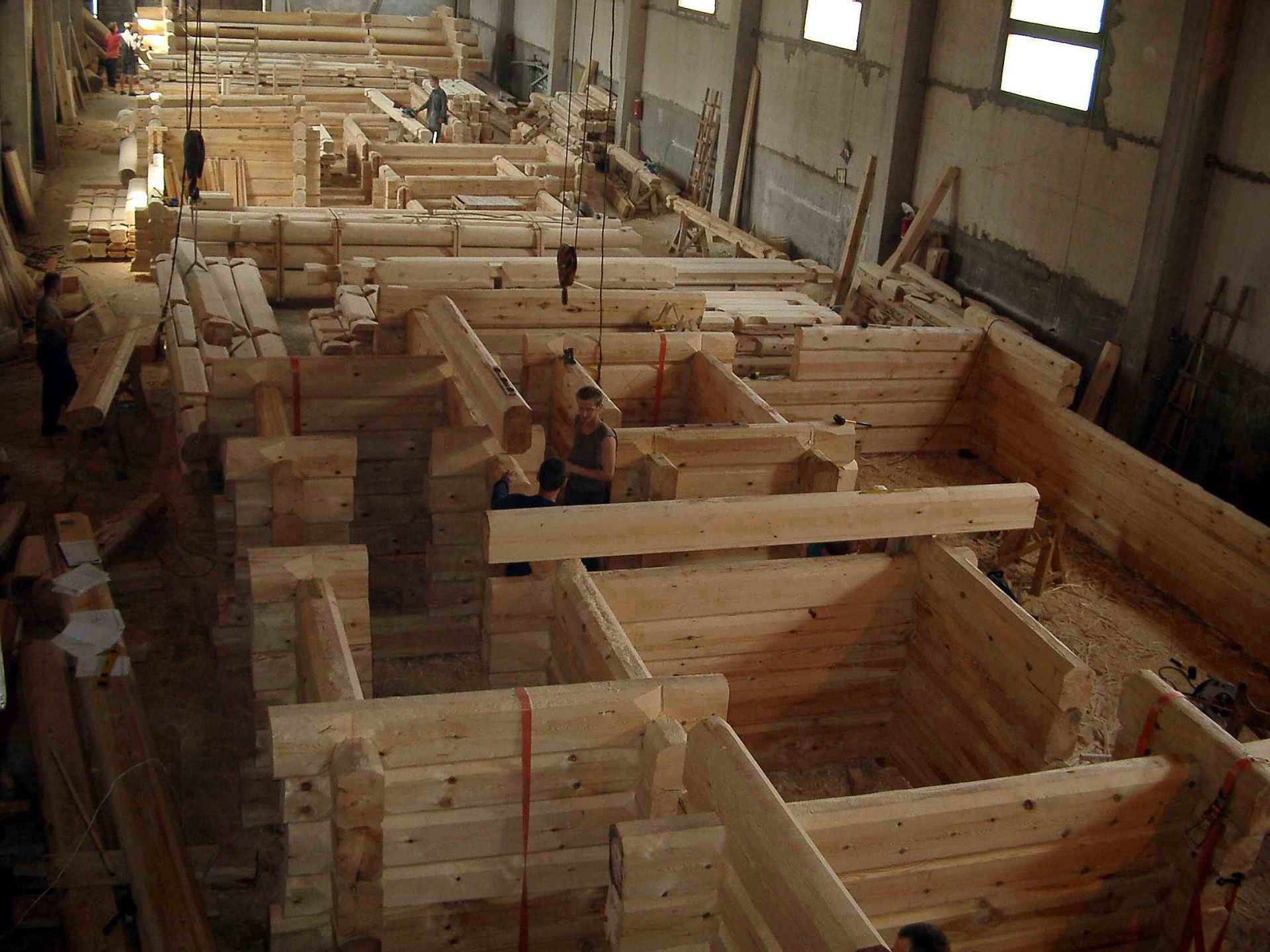
Faced with the problems of the human factor, quality, efficiency and cost, we came to the following question more and more often: Can this complex corner joint be created industrially at all? And precisely at that, preserving the shapes and qualities tested over the centuries? How can one make sure that the overall visual image of a log house does not differ from that of hand-work?
Log buildings should be manufactured from logs of many, i.e. various heights, retaining the authentic performance of the corner joint!
The set goal sounded like this, almost utopian-like at the time. However, in 2003, the first log house constructed in this way was presented at the Lillestrøm International Exhibition Centre Exporama, and the first secure steps were taken to enter the Norwegian market, which has very old traditions in this field, a deep knowledge and high requirements.
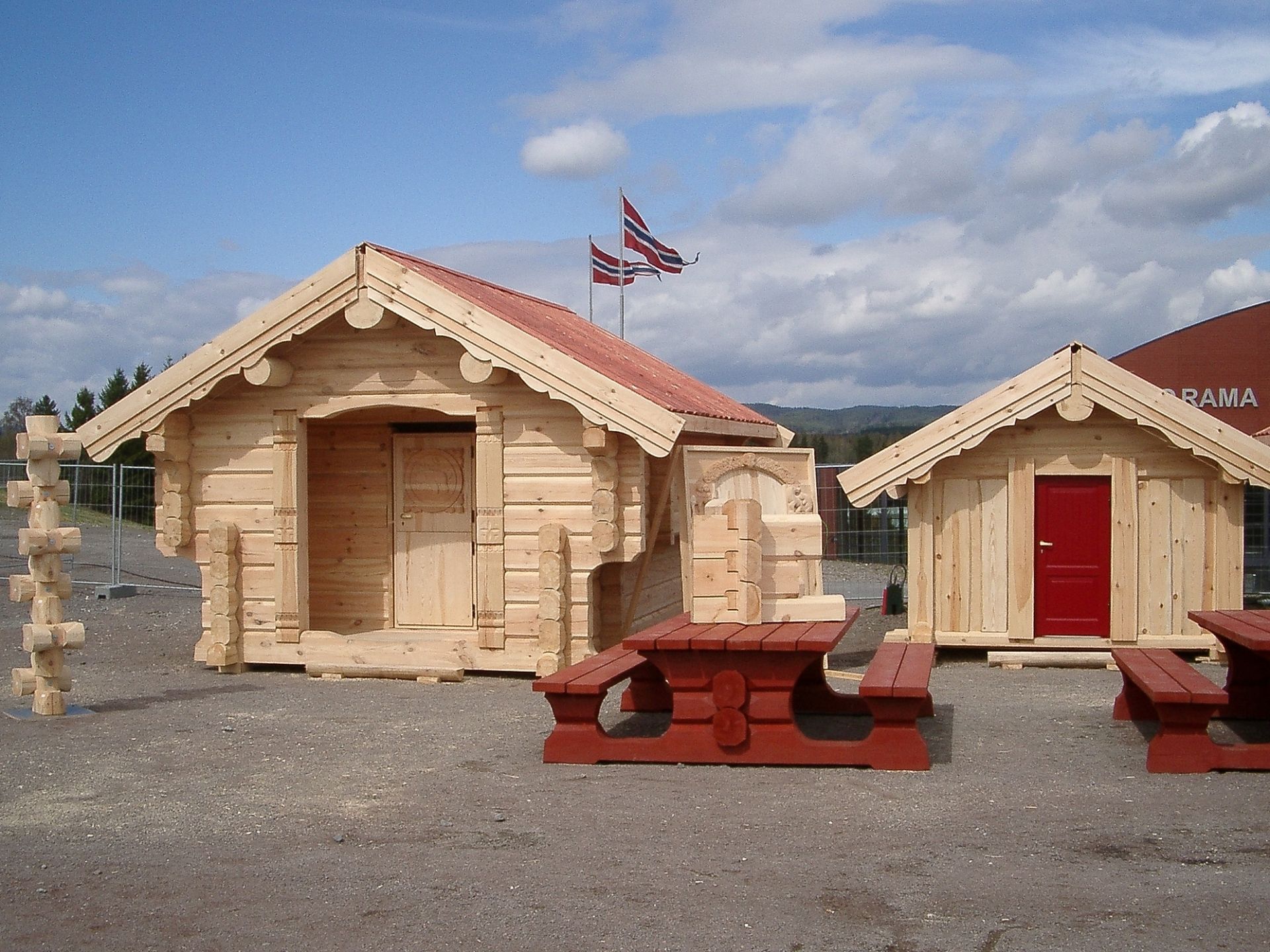
Of course, it took some time for the new product to ascertain its place and erase skepticism among many customers, competitors and specialists who basically recognize only hand-work. Step by step, our product continues to gain the trust of our customers, and it instils the confidence that an industrially manufactured log house can visually come closer to high-quality hand-work and prevail in terms of the precision of joints, and that is not all…
We continuously invest in the development of our company, the area of the production premises has been increased to 30 000 m², new, more modern equipment has been made and the existing ones have been improved, innovations have been introduced in the wood drying process, specialized design and equipment management software has been improved and supplemented — new joints, millings, new beam profiles and thickness, barcodes and automation has been implemented.
By strengthening the continuous confidence and interest of our customers in the log houses created by EKO NAMS, and also our trademark SKANDINAVISK TØMMERHUS, we promise to never cease implementing new developments. No matter where the wind blows, we believe that log houses will not disappear as long as trees still grow on the Earth. Their unique charm and the natural microclimate of trees is capable of mesmerizing anyone.
Here is how a completely correct corner joint of logs looks like, and since 2003 it has always been like this:
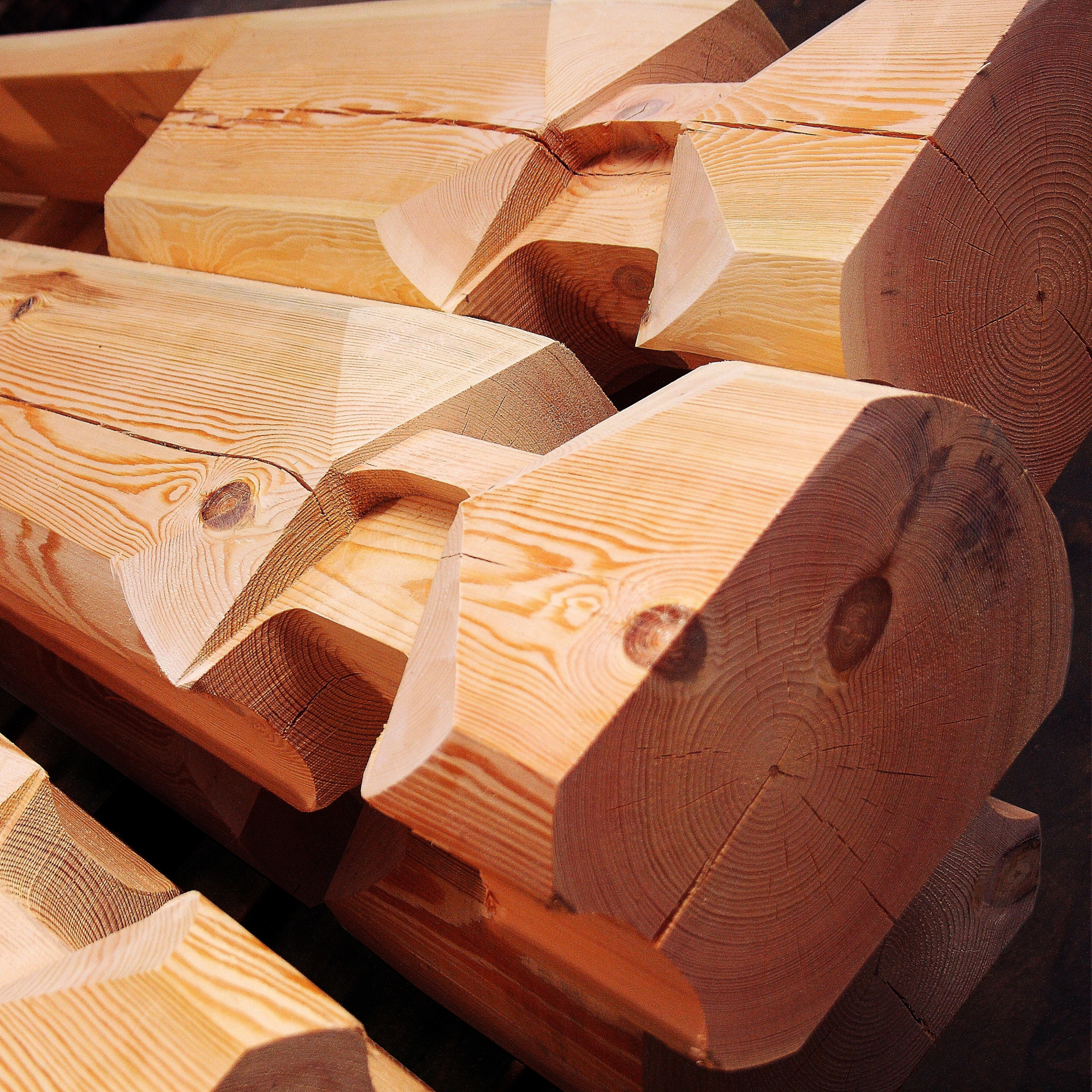
This was our spirit 8 years ago, and it has remained unchanged to this day, but the passion to act has only grown. Yes, but it seems that the era of naïve poetry has disappeared from this world over the years, so the time has come for us to get down to business. This time, in a slightly different manner — with facts, proof and evidence, because the following could be undoubtedly concluded from the esteemed professor’s speech, from other excerpts from the contributions of the log house conference participants showcased further in these postings, from the collective position of all participants:
The manufacturer’s obligations include informing about the nature of the new product, and about its qualities.
In other words, it is always necessary to present your offer (our offer, this time) to the public, using all the arguments at our disposal. Arguments which would also make you think, arguments which would help you to assess and understand the situation in a more objective way. Except you will have to forgive us for both such a free and unaccustomed type of writing, textual, stylistic and expressional errors, as well as all the countless ethical violations expected in the continuations of this blog. In any case, we still need to take action – we must educate you. By the way, this small house in Norway’s Fagernes (Blilie) area was the first order of our new product. Delivered at the end of 2003.
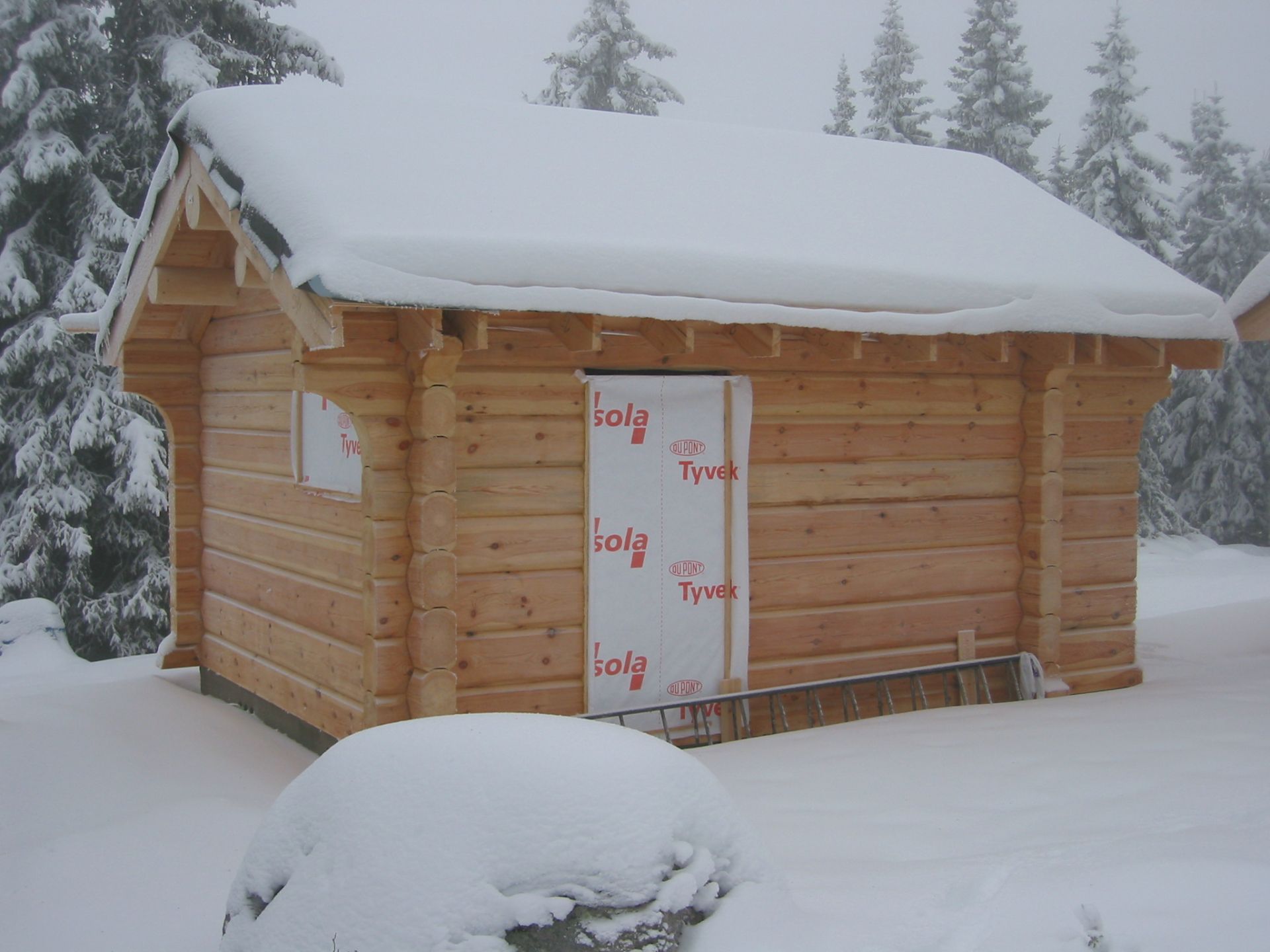
So, these articles, or the reflections, nowadays called blogs, must reflect the current, rather problematic situation in the industry of oldest building created by man – log houses – and we must draw your attention to the qualities currently available in the Norwegian and Scandinavian market. Of course, in the further issues of these blogs, perhaps even at the end of each one, a comparison and/ or information about the qualities that we offer will be included.
To be more precise, it is completely clear that no one should dismiss the Norwegian market. The market respecting the log house the most and with the most knowledge in this field. Therefore, we will look into the problems and difficulties present in this industry, and describe to you in detail all the different situations and challenges one must face in this industry. We will also talk about in what way and how difficult it is to create something good, or about how irretrievably valuable craftsmanship skills and traditions can be degraded.
You see, once again, the emotions hit a high note, and once again, we must warn you that during the series of these articles, open fights reflecting on our development front will be showcased, and we will definitely not be able to sit still and not express our pain. The pain for everything that has accumulated in our hearts over these years of growth, for how our plans and growth has slowed down, for what it feels like to fight alone, one against a thousand others. However, during such emotional explanations you will certainly be able to understand the basis of the battles we have begun and perseverance, to read about it between the lines. We ask you to not be afraid of the rather unpleasant facts, statements and conclusions, of the prickly vocabulary of our reasoning, of our unmistakably quarrelsome approach.
If you didn’t know this yet, nowadays, if you wish to retain the reader’s attention, information must be presented strikingly and colorfully enough. That’s why we present photos of a typical hand-made connections, i.e. with obviously low quality, while accuracy isn’t there and never will be.

As well as a photo of a typical shape for log grooves. Such a “kitten” grooves predominate in places where they are not visible from the ends of the logs, for example, in the section of the logs in between corner joints. However, such an execution dramatically increases log building’s settlement %, as well as tearing apart the ends for log overhangs.

However, you definitely do not have to worry about the fate of log houses or about the severity of our expressed criticism, because we have already found or are preparing a solution to any topic or issue highlighted by us. We will talk about this at once, or a little later on in one of the future postings.
Excuse us, but as for you, the potential customers wishing to obtain our log houses, everything is in utmost and complete order. You will only be presented with positive news in these articles. And, to be honest, the whole story will, in principle, be about the importance of our contribution to the industry, in its essence. Because it is precisely this contribution that you and the public must finally learn about.
Of course, on the contrary or even quite sadly — the conclusions included in the articles will surprise all the proud log house manufacturers. Those who excessively overestimate themselves, tending to think of themselves in such a way, those who truly mislead the public by making everyone address them as such. Yes, exactly — with the help of our “beloved” marketing. However, this is how it is in life — there is no good without evil, and vice versa. The pressure concealed in blog texts will be transparently and purposefully aimed at shaking up any user of the weakness or situation in the industry, anyone endangering log houses. Do not even expect the force of this grip to ease up. Our reasoning will certainly reach all those pseudo-manufacturers whose only achievement is that they have managed to push craftsmanship out of the market, all those amateurs who have done absolutely nothing for the log house industry, who have only allowed themselves to vegetate out and do nothing and who have managed to degrade everything which they have seated themselves on so comfortably. It seems that at least the invitation to fight has turned out to be juicy enough, aggressive enough.
The article is accompanied by 2 photos from prosperous Sweden. In Norsborg, on the outskirts of the country’s capital Stockholm, is (or was) the holiday cottage exhibition village ‘Husmässan’, with such a glaring masterpieces of handiwork, evidence of the aforementioned degradation. But not with the idea of exposing mistakes or maximum clumsiness, but with the idea of selling such handmade log houses.
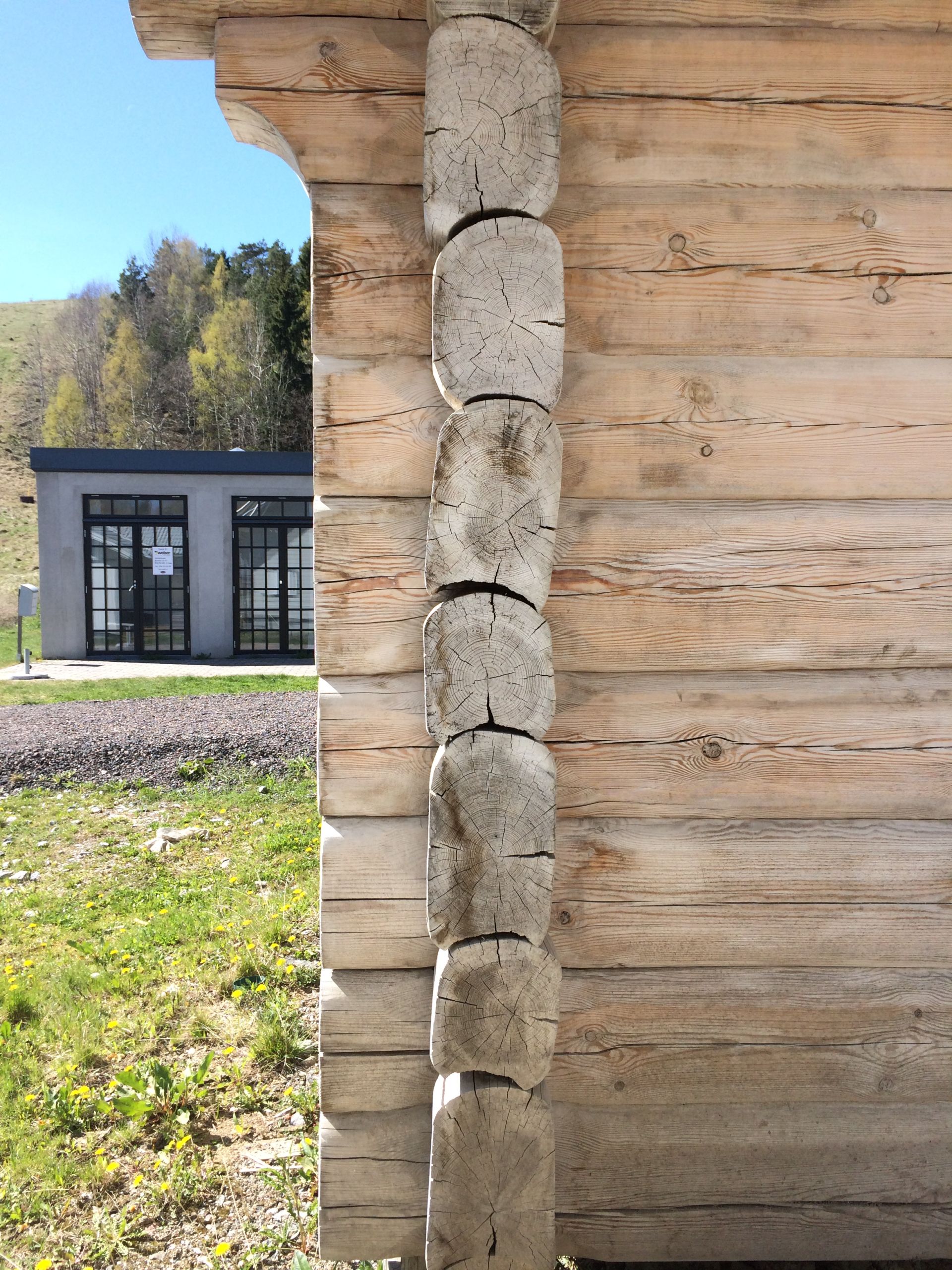
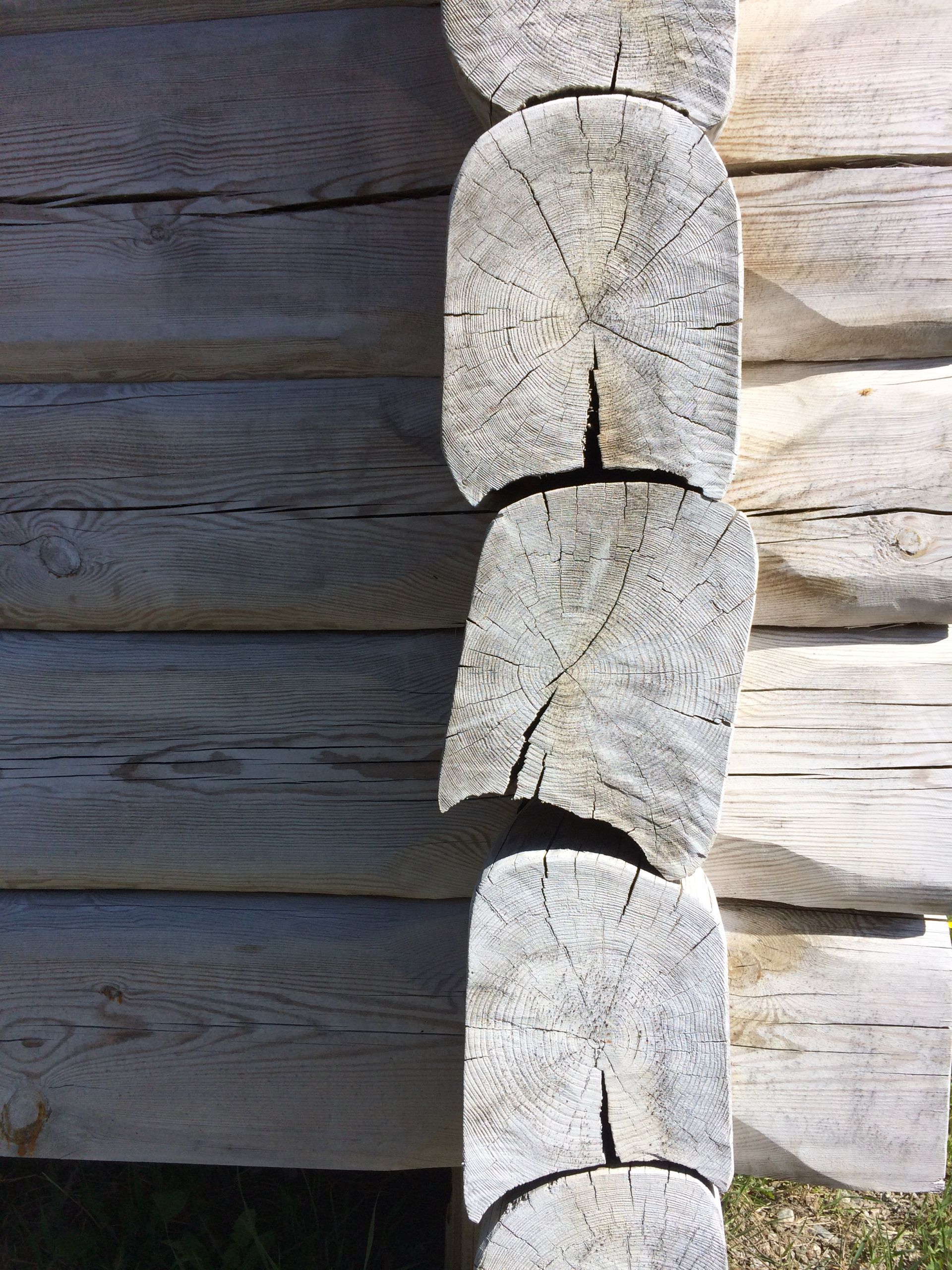
Unfortunately, but, still, it is very likely that many words and expressions will have been toned down or disappeared in translations to English, Russian and then — to Norwegian. Please accept our apologies, but it was not possible to find a sufficiently professional Latvian-Norwegian translator. All right, who do we intend to address with the help of these series of articles?
Firstly, all potential customers and a multitude of log house devotees, all those who have already decided on or are just thinking about purchasing and constructing a log house. The purpose of these articles is to firstly make you think, then weigh all fors and againsts, and then verify the facts yourself and make sure of everything in real life. Perhaps we will finally achieve the fact that you do not lose your inner peace and confidence in the validity of your choice, the fact that you will be able to rid yourself of the feeling of insecurity, concern or bad premonition in this log house market carousel and among the variety of offers. By the way, if you decide that our offer is the right one you can inquire about our product with trusted builders, or simply put — builders of your choice. You will be able to safely request the delivery of this exact type of a log house frame, and its inclusion in your construction project. Too much insistence on your part will not even be necessary, because we will not refuse anyone who accepts our model of mutual cooperation.
Secondly, we would like to reach out to all enthusiasts and professionals of the log house industry, all woodworkers, carpenters and hand-work log house craftsmen. Both large and small construction companies. Those who help customers to organize a full construction cycle, those who were or will be ready to get involved in log house related ventures, those who are still purchasing log house frames in, God knows, which corners of the world, as well as those who are still performing this complex log house operation by hand. It is clear that, from our side we will be able to establish a very acceptable model of cooperation with everyone. We blindly hope that we will even be able to encourage to change those who so stubbornly still stick to their hand-work. By slowly describing the current situation of the industry and presenting the qualities of our product. Nuanced, step by step, proving the unquestionable superiority and reliability of our log houses.
For example, like this, with a photo of a cross-section of our corner connections. There is the same 10mm seat clearance throughout, both in the corner joints and in between the logs, plus angled corner joint tops for a smooth, controlled settling. With all these log house dilemmas, we will certainly help you to get clear, because at the end of each of the following articles, an easy-to-view table comparing the n-th quality criteria will also be published.
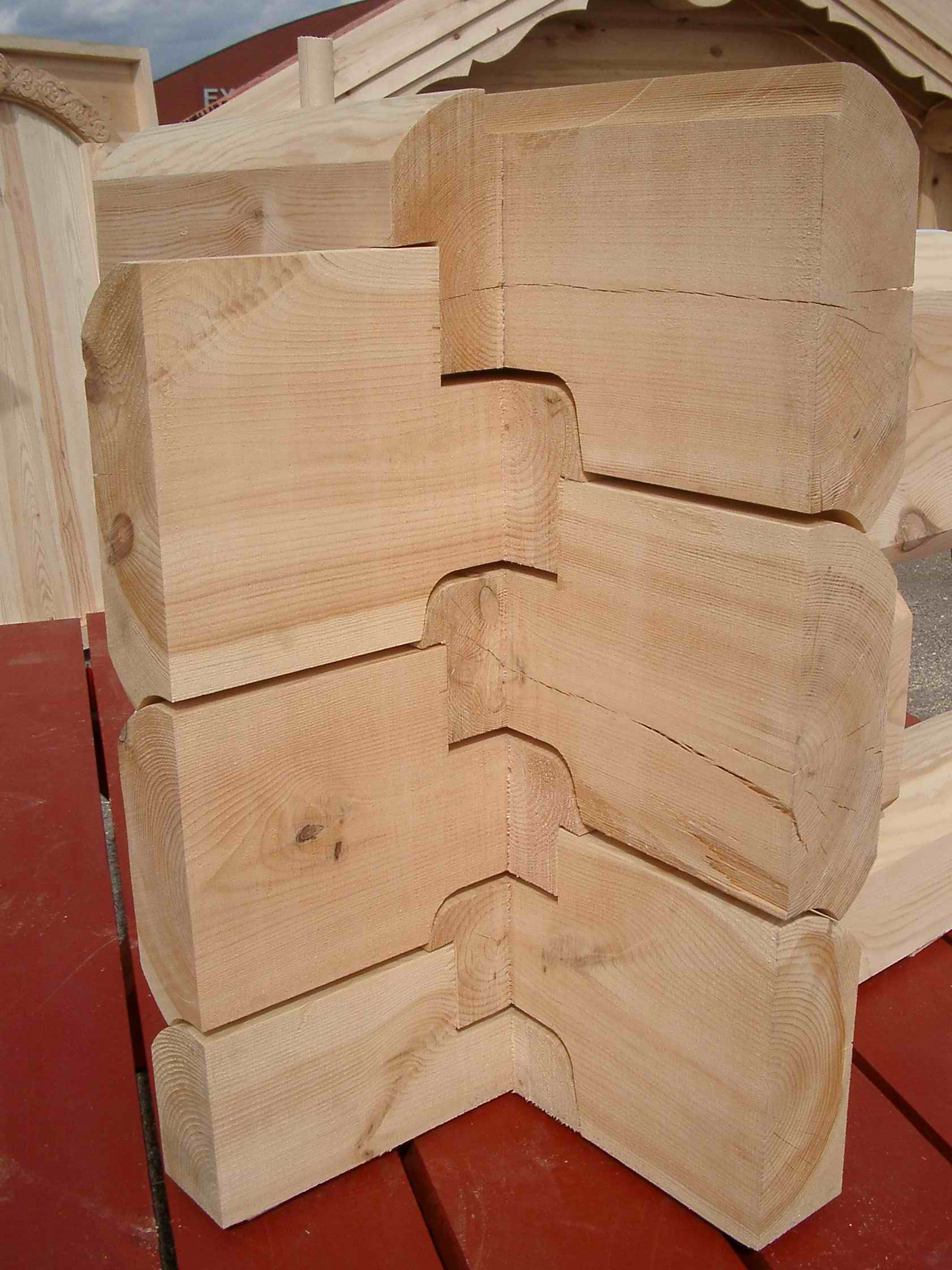
Yes, we are perfectly aware that we risk causing dissatisfaction among hand-work enthusiasts and log house craft masters, even causing a storm of outrage and resentment. However, if you think about it, and with a cool head at that… There is, however, reason to conclude that the seed of resentment and other unstable emotions can only be found in an environment of false, insecure masters and unstable businesses. Whereas, constructive criticism cannot in any way upset highly qualified and confident craft masters; moreover, they will certainly be able to understand the true intentions behind our reasoning by considering and assessing the problems and facts included in these blogs.
Hopefully, they will agree with us that, in principle, these articles help to clean up the space for the artwork of craft masters as well, and that is not the ultimate goal of the articles to eradicate hand-work. That, in fact, their aim is to expose and push aside the false, fake, superficial, degraded, performance-wise inexpensive, low-quality, so-called “hand-work” and, consequently, prevent further degradation of log houses’ reputation and subsequent destruction. We can only hope that all the frustrated and scared ones will understand it too, and unconditionally agree to everything. Hopefully, understanding will be accelerated by the misdeeds of these madcaps, the “best” of the best:
Perfect log groove and profile transition.

The corner joint was corrected with “rigid” slats, and in addition, this horrible nightmare was covered with a putty, just to be sure.

Will a log with a very expertly pasted fragment work for you? In other words, cheeks of previous connection or the error is almost invisible.

By the way, our position is identical to the way it is understood, recognized and commented by the prodigies of the above-mentioned log house conference from all over the world:
Hand-work has its own place and always will have one, even on a level of hobby. Hand-work must be preserved, passed on, cherished, but it must not be the way it is now, so mutilated. And, without a doubt, it must be understood that technical progress is inevitable, that everything is evolving, and there is nothing bad in it all.
And at the end of the introduction, we once again come back to the most important question for you — choosing the right manufacturer (Supplier). We really do not envy you (the Customers), in this sense. You have to look at the advertisements and websites of many different manufacturers, you are forced to aimlessly read through all these offers, descriptions and company self-advertisements for days, for example, by reviewing all advertisements and websites available on the internet portal hytte.no or elsewhere. And how much more of your precious time is lost by looking for additional information elsewhere and all around the internet? Or do you not have the strength for it anymore, unfortunately? It is clear that this activity is quite exhausting, but nothing can be done, it falls within your Customer’s responsibilities.
But you at least have a pile of money, and must do what you must do. But how do you tell who is a manufacturer, who is simply a representative of a manufacturer, who is a newcomer to the market segment, who is an avantourist, who is an intermediary, who is the real deal? Mistakes are out of the questions, because this error may cost you too much, and all in all, it can all end in tragedy. For real, how can the Customer choose from more than 150 advertisements on a portal, what should one do with the flashing ads, banners, posters, Google ads and so on?
Which company should one contact, where to begin, how to cross-check them all, which one to visit and spend both time and money, which one is to be even trusted? How does one not get confused here with everyone declaring that they have experience, all kinds of certifications and, of course, that they are very professional, qualified and honest. But it is possible that they are only skillfully manipulating with you. How can one determine which is the right company, which company has it in them, which is a know-nothing, which is a hardened pretender? No one wants to toss their coin around. How can one be sure of whom to even ask for help and advice? And then come the organization of price surveys, comparison of all the budget estimates, different delivery lists, contracts and conditions. You can become overwhelmed by stress, despair, helplessness and apathy, your head simply starts spinning.
Photo: Stand of our former cooperation partner Norsk Laft AS at the “Hytteliv” exhibition. Lillestrøm, Norway, year 2004.
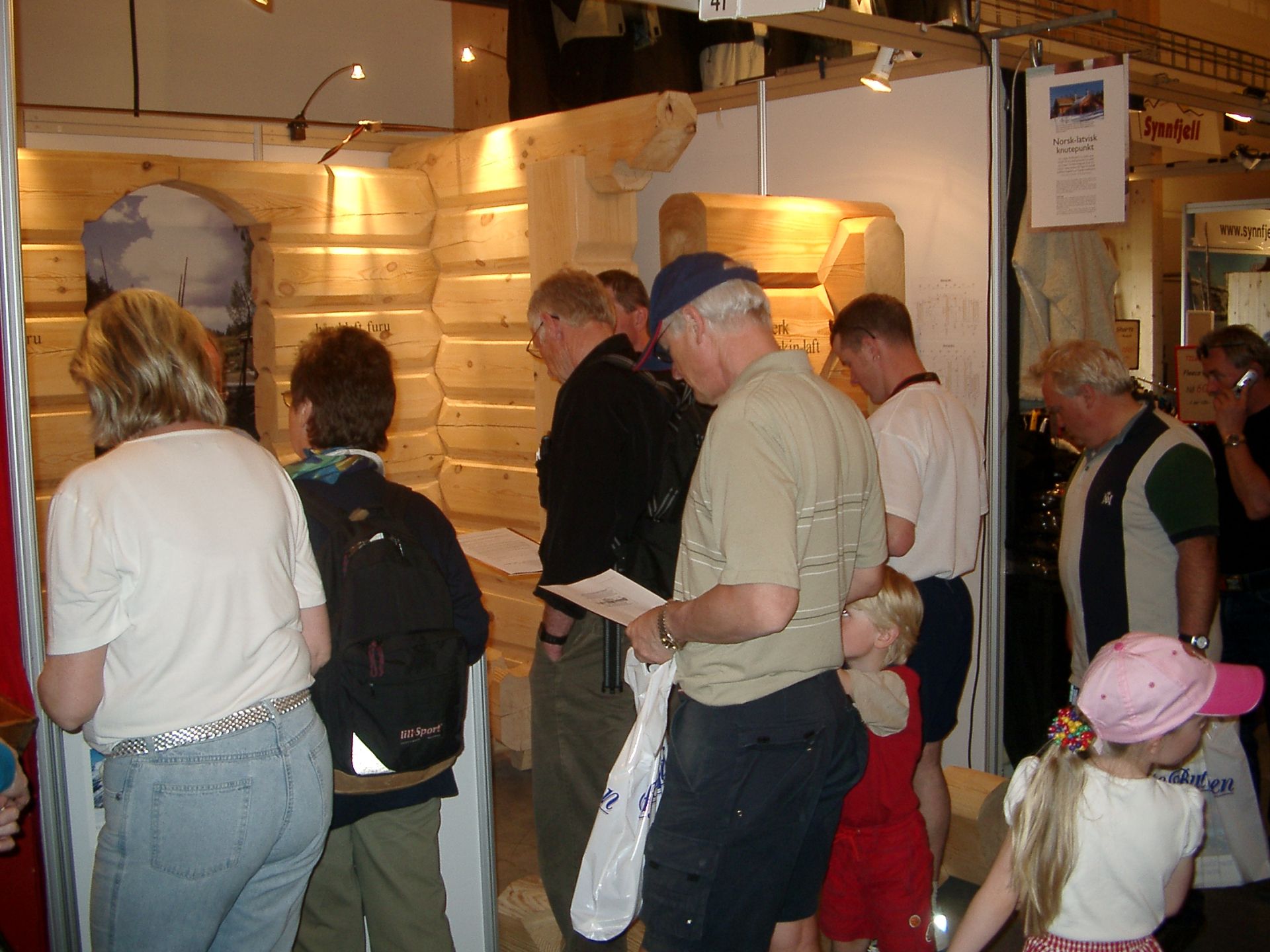
Fine, enough of scaring you. Of course, most people are convinced by some simple advice from their friends (only trustworthy ones, however), by what they or their friends have seen, overheard and what they have read. It is clear that it would be most befitting the interests of the Customer if he was offered several, popular and tested universal manufacturers, independent brands, which, most importantly, had been selected due to objective and demonstrative quality, and ones whose product quality and professionalism any of the builders (Suppliers) can fully rely on. Official statistics on the main players of the log house market and the most important parameters would be very useful: quality, price and order completion time comparisons, business trust indices and ratings, brand recognition studies, etc. would also be good to have. I suppose it is enough of fantasizing, because no one is going to offer such extras and statistics to you in the foreseeable future.
However, unfortunately, alarming signals can be sensed again… Namely, some rumours can be heard that currently most often market players find themselves in a situation where the builder and manufacturer are not so independent and objective after all, that they are both legally and financially linked, that the manufacturer is a foreign company wholly or partly owned by the builder himself, that this experienced builder (the seller and the supplier), often very desperately, manipulates and misleads potential customers in many different ways and sells them a product of a low-quality “hand-manufactured” product simply in order to obtain as much orders as possible for his self-owned factory, precisely for his own factory. Besides, for a very high price at that, a price usually set for great “hand-work”.
Well, but at least in our case, all these struggles can be spared for you, because remember — the most convincing are the recommendations from friends, what you have seen and heard with your own eyes and ears and what you have read yourself. And you won‘t have to look for anything, you won’t have to dwell on it, everything is safe and amazing, everything has been checked. A unique technology, an amazing, tested and easily identifiable product. Can be identified only disassembled, upon delivery or during assembly. Only then can corner joints, millings and drill holes can be seen. It will be incomparably harder to identify the origin of the product once it has been assembled since the overall image corresponds to a high purity of hand-made log house. And then even the experts get confused, including us, of course. The product has no analogues, it is exclusively manufactured by a single company. Even exhibition companies use the houses produced by us for their advertising posters, because the pictures turn out to be both concrete and beautiful.
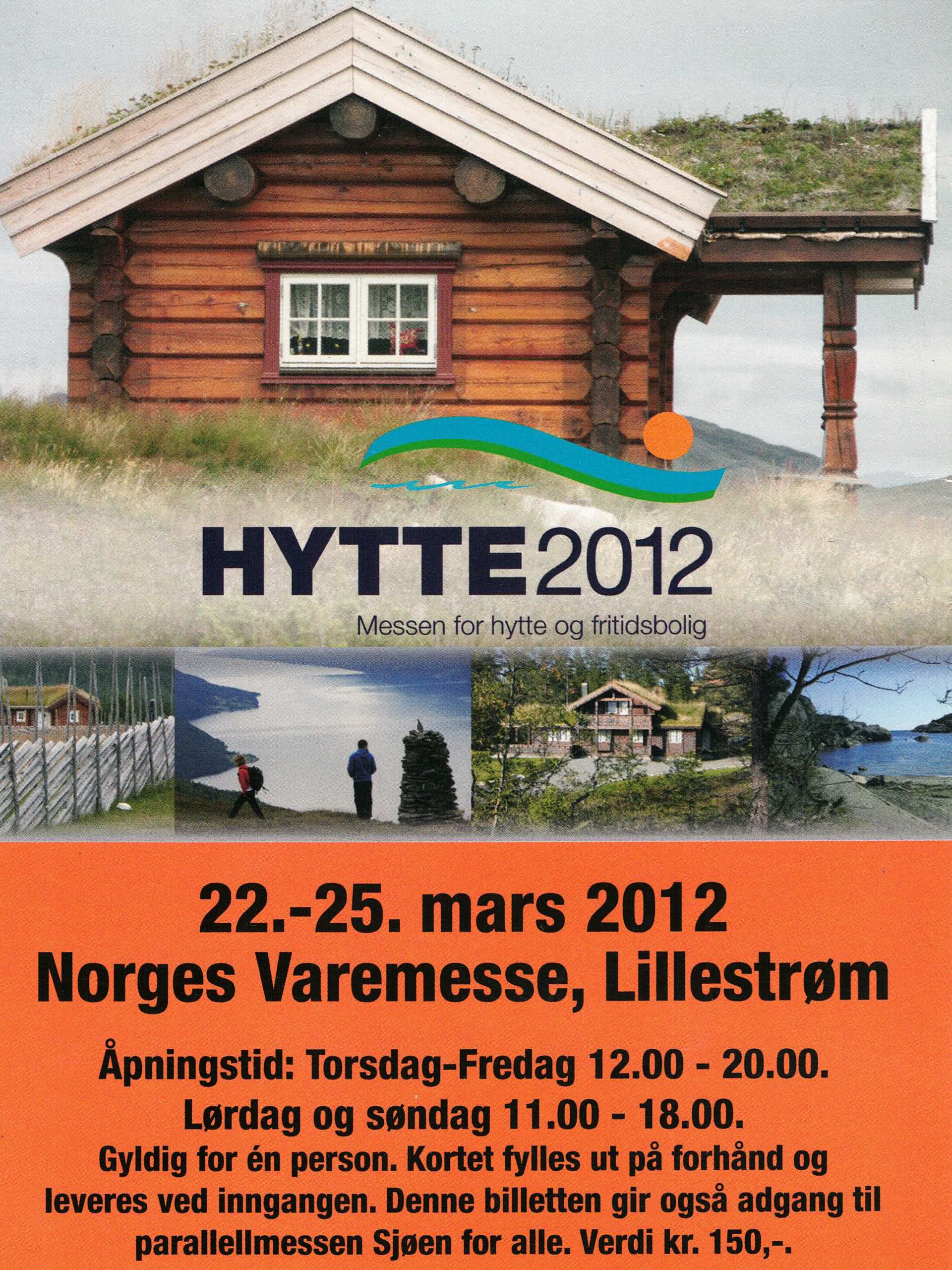
However, if you plan to continue searching between 100+ companies looking for a fantastic alternative, we invite you to consider this before commencing this feverish activity. Isn’t it a bit more reasonable to read this series of articles/ blogs beforehand? Peacefully, on evenings, at your own pace — part by part, theme by theme, or in a mixed order. For example, by devoting evenings of a single week. And maybe it is not worthwhile to rush, to squander your energy? But what you read will surely shed light on, explain and clarify some things. You will also become much more erudite — that could certainly be useful for you in search of the right or the “real” manufacturer.
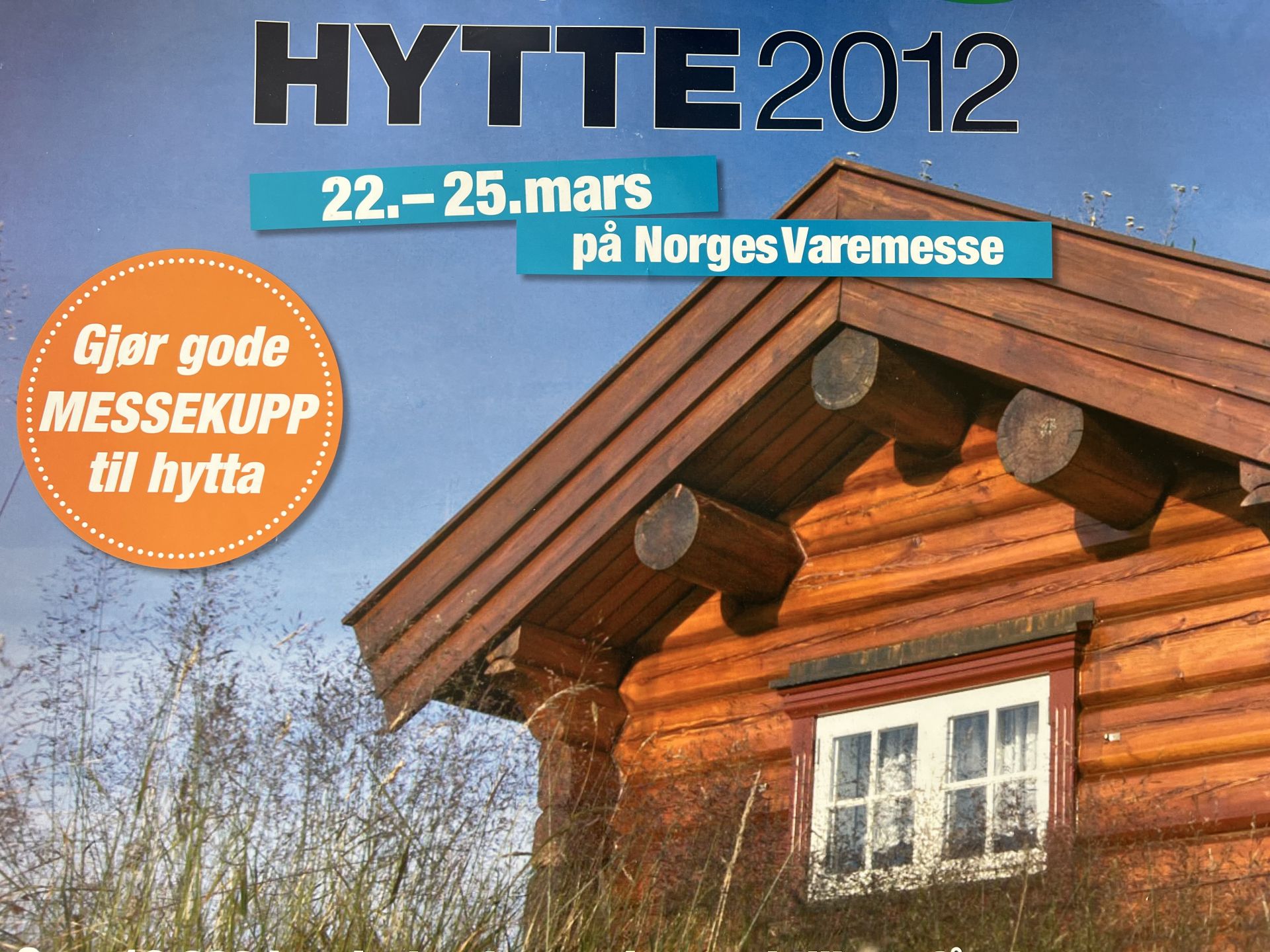
However, a great risk exists that during the reading process you will be convinced of a lot, also of the fact that you now have free access to a much higher-quality log house, even the log house business. And even if this will truly happen, that is a good thing, is it not? Wishing everyone happy reading, with best regards,
Ervins Poga, member of the board
![]()
By the way, in order for you not to think that someone is talking nonsense in these articles or, even worse, brainwashing you, we invite you to read the short two-page version of our brochure in the appendix. The brochure systematically, in essence, reveals all the nuances of our product, without missing any of the elements of log house structures which are valuable in regard to preserving tradition. Although this is how we lay out all our secrets in detail, we are not concerned at all about our future simply because we are not stagnant in our development. The path to implementing all of this in real life will be long and difficult enough for anyone.
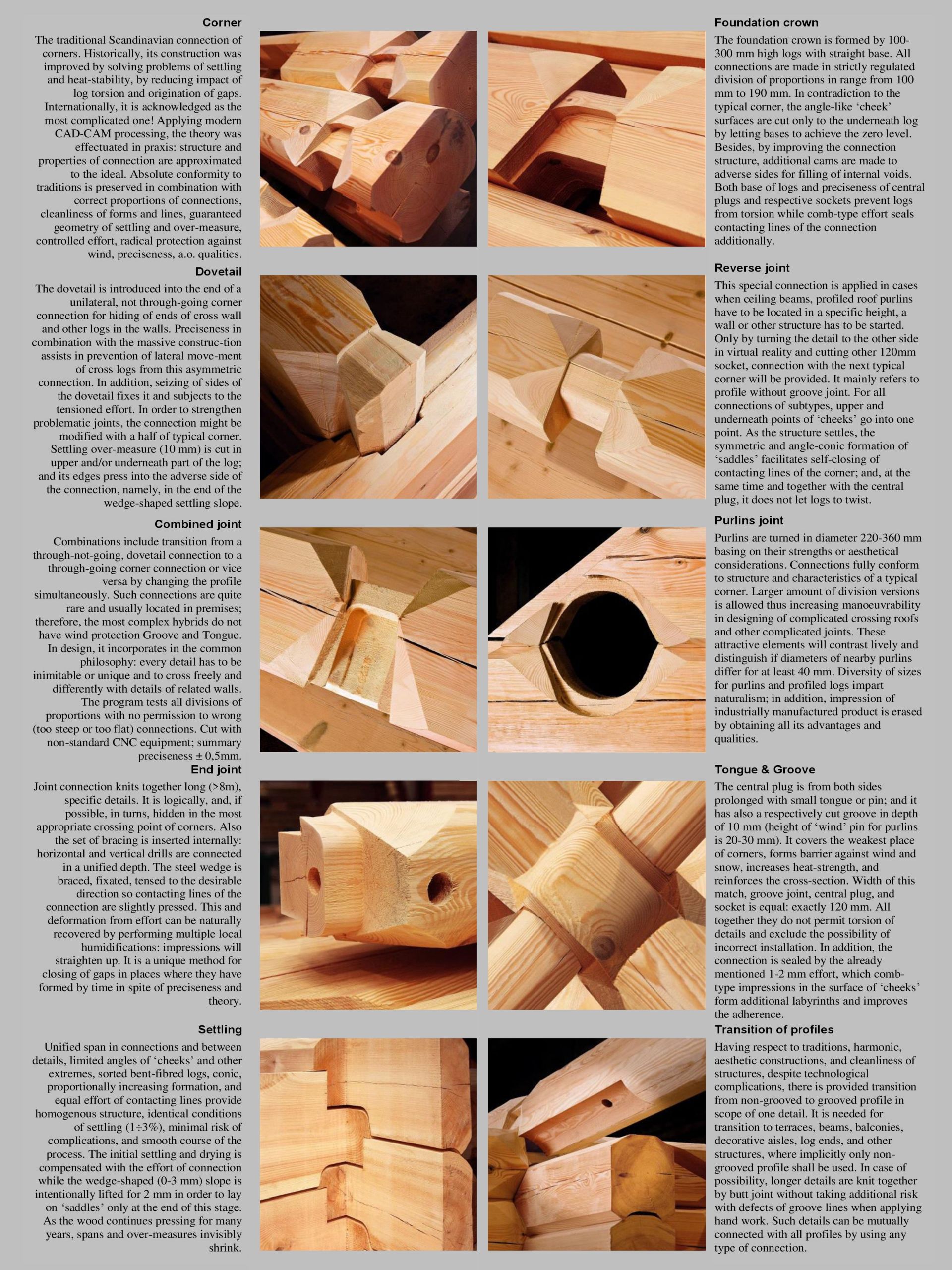
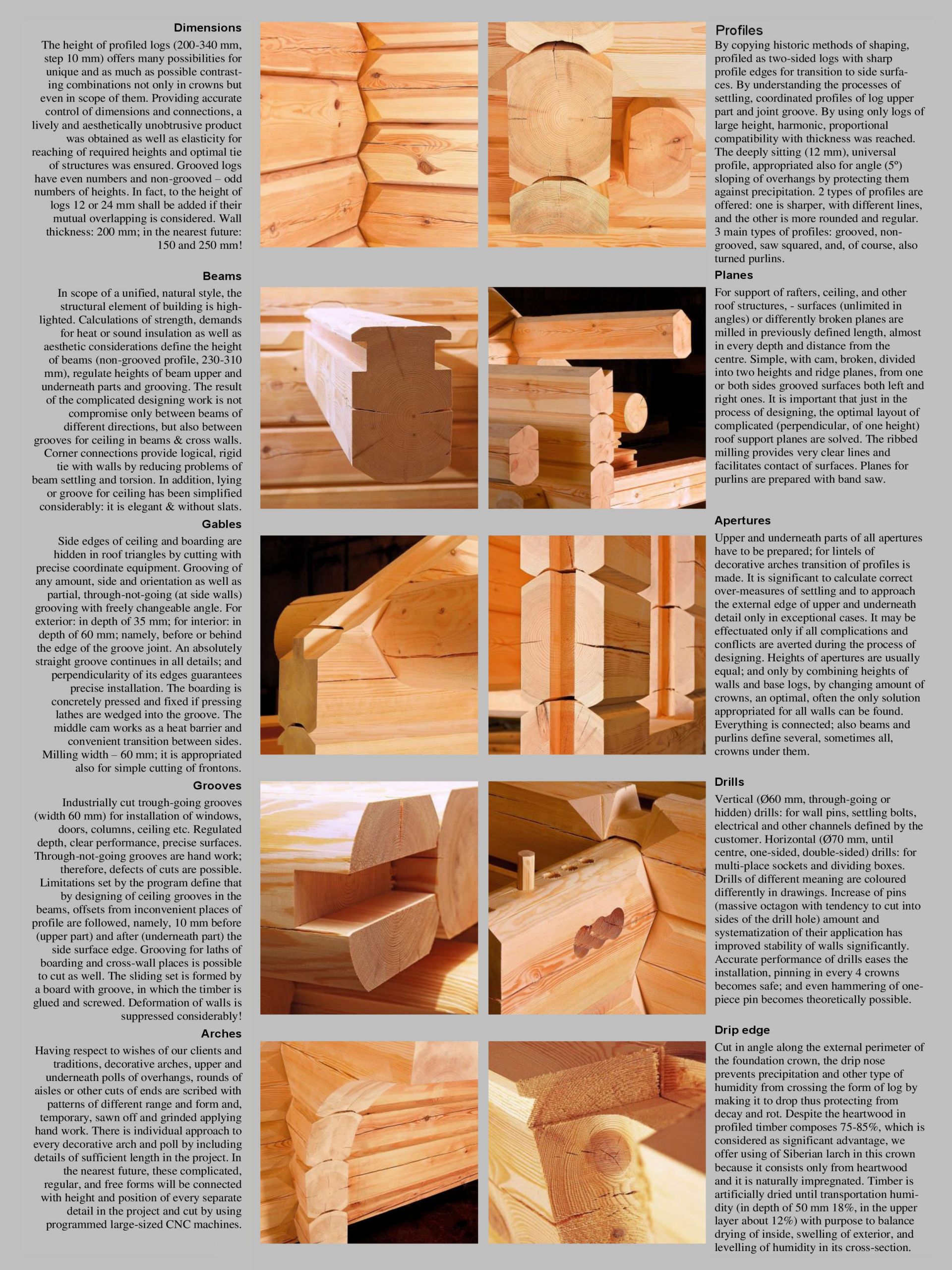
By thoroughly studying all the small details of the construction of log joints described therein, you may come to the realization that the brochure can also be used as a handbook for any of our followers. At least, during the brochure creation process, everything was willingly revealed, with a relief that the matter had been resolved and that the product is in working order. In other words, nothing was hidden or concealed from you. Will the industry professionals acknowledge that our product is not necessarily an expression of some excessive nitpicking, but that it has been shaped in true respect for the wisdom and ancient traditions of our ancestors? We hope they do. Because by doing our best to preserve or even save these traditions, we also gave ourselves an additional task: to improve the quality of wood buildings, which can be characterized as quite specific, to create a harmonious, beautiful and finished product, to create a modern and lasting technology. And here comes the promised comparison table:
